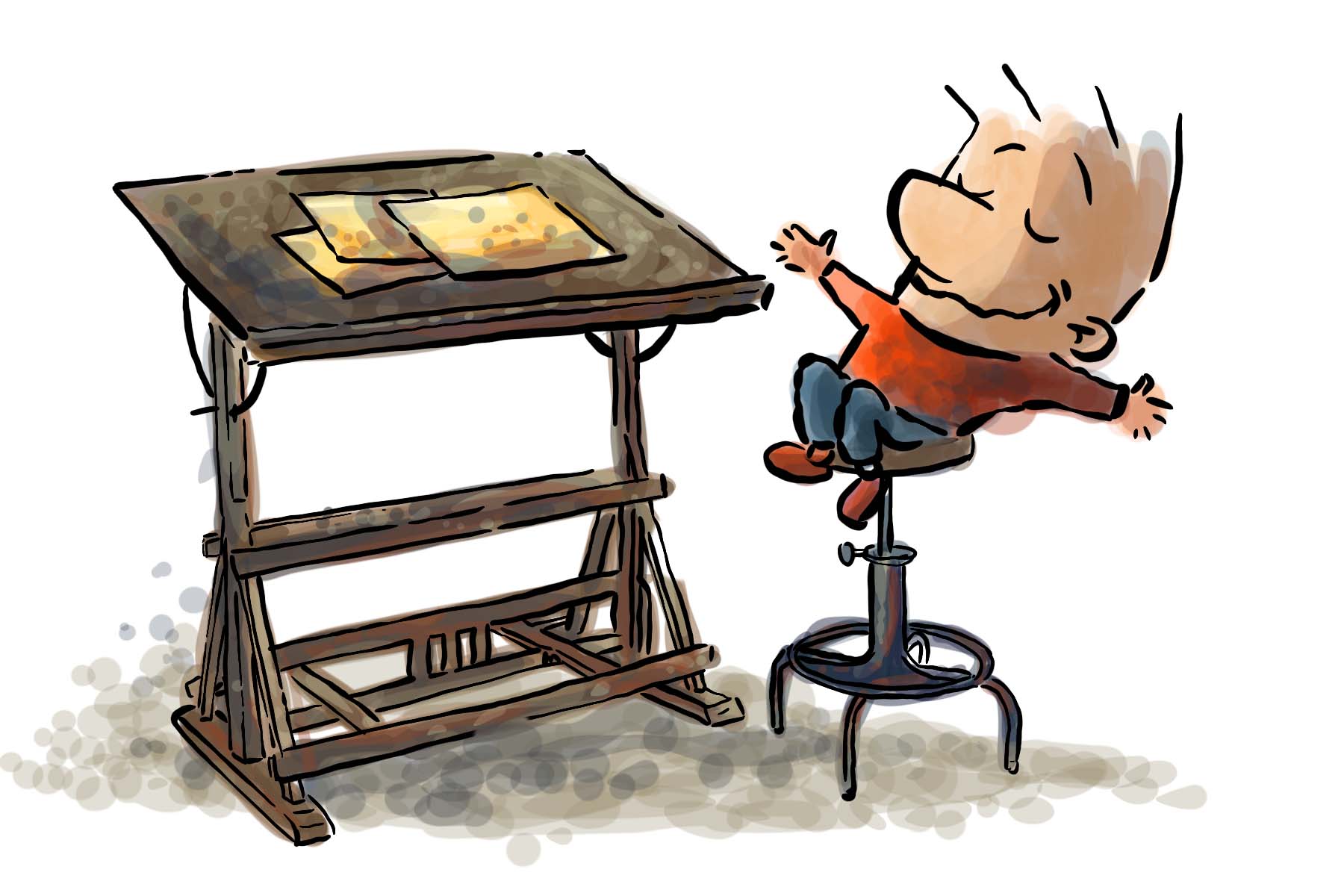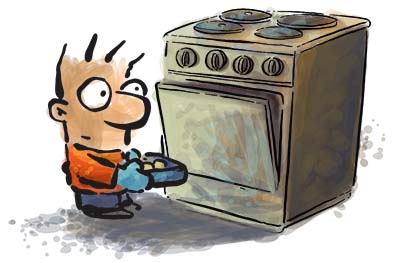
The StoryTelling Live Online Course With Sean D'Souza
Learn how to construct a story with confidence, so that you can confidently use it in your writing, speaking or on video.
How to stop a story from going off the rails (and boring your audience)
We are all capable of telling stories—and telling good stories too—but how do you know when your story is compelling, or just boring?
When a five year old comes home from school, it's likely that she has an interesting story to tell. We too, are reasonably good storytellers. Get out a bottle of wine, some delicious food, and we have stories of our last trip abroad, of a pet, or just a business story that got our attention. However, these delightful moments of lucid storytelling seem to scuttle away the moment we're called on to tell a story that will help us in our business. When we manage to string a story together, it often feels dead, too technical or downright boring.
Worse still, our lives seem so mundane, that we can't imagine how we'd use our own experience to tell stories.
We like the idea of telling stories from our own life. We see good storytellers use their day to day lives to tell amazingly rich and wonderful stories. When we look at our own events, however, we feel the walls closing in on us. Who'd be interested in our boring, tedious lives, we think to ourselves? If we were able to master the craft of storytelling, we would not only have an abundant source of personal stories, but use the same system to tell third-party stories as well.
And it's not like we don't try to get ahead with our storytelling skills
We spend hours on research, trying to find a story that fits. We even make notes and try to put the story together yet we can't seem to rid ourselves of the dead weight. The story doesn't feel light, bouncy and certainly not dramatic. It seems to go nowhere. At times we are so bored with the story that we can't imagine the client ever bothering to read it, let alone liking it.
Presenting: The Traffic Light Storytelling Course with Sean

Storytelling is quite like a fairy tale, quite Cinderella-like.
The formula is so simple that it can be boiled down to a “traffic light”. There's red, amber and green. Or to put it another way, “stop, wait and go”. When you look back at all the stories that you've enjoyed—like Cinderella, for example—there's a lot of stopping, waiting and going” before the story finally resolves in that happy ending.
The problem with our stories is they miss those ups and downs. Our stories feel a bit sequential. Just one thing after another, with no drama, twists or turns. And yet, almost every activity in our daily life can be brought to life like a fairy tale. What seems to be mundane, depends on how you look at, and then re-tell the story.
In this course, we'll not only examine what makes a story interesting, but we'll write boring stories too.
We'll strip out all the drama and interest and then we'll put it back again. This way you'll not only know how to write a great story, but also how to spot the bits that make good stories dull. The end of “boring stories” is in sight. You will find, to your amazement, that your life has stories of wonder. Now, all you have to do is learn how to tell those stories to an eager audience.
The three-stage process to writing compelling stories
Stage 1: Deconstruction and Reconstruction of what makes stories interesting (or boring)

Analysis of interesting stories and boring stories too
It's easy to fall in the trap of trying to write interesting stories. While writing a dramatic story is truly satisfying, the real route to writing is to learn where things go wrong. In this course, we will learn how to write powerful stories and then remove the elements that make it powerful, thus causing the story to be boring. In this manner, we'll avoid the fluke of writing a great story every now and then. You'll learn to audit your stories and see how to always make them get the attention of the reader.
Learn how to find a precise point of interest, and stop wasting time trying to find a great story
If you've struggled to find a great story—either a personal one or a case study—you're not alone. However, a bigger problem arises when you find a story that has too much drama. How do you keep to the main point? You'll learn how to avoid “trying to find the story” and instead read until you've found a point of interest. Then, we'll go about creating a story from that singular point. This not only saves time when you're trying to put a story together, but it avoids the unnecessary detail that seem to drive readers crazy.
How to write a seemingly endless amount of engaging personal stories
“My life is boring”. That's what we all believe. And yet, when we're relaxed, we tell stories of our lives that are incredibly riveting. The problem that we face is how to bring up the stories that we've told in the past, and tell them well. However, it doesn't stop there. We have all have a treasure trove of memories that we need help digging into. You'll find that you almost never run out of personal stories. Then, it's merely a matter of using the traffic light system to make the stories come to life.
How to have a mix of personal stories, analogies as well as case studies in your writing
Some of us love to tell personal stories, while others are not quite ready to do so. In which case, we will need to rely on analogies and case studies. No matter what you finally decide, you'll have the ability to use all three methods to create variety in your writing, speaking and video.
Stage 2: Creating drama with ups, downs and flats
Why the downs create the bounce and drama in the story (and when to use it)
Most of us aren't sure why our stories aren't that interesting. The reason is because we don't have enough bounce in the story. Learn the power of “downs” and how to use them strategically to get interest in the story. A story without “downs” is just a sequence of events. However, the moment we put in the “downs”, the story comes to life.
How to use a series of ups and downs to move the story forward
While “ups” and “downs” are crucial to the story, there's also the danger of adding too much. Too many “downs” will cause the reader to feel anxiety, even a mild form of depression. Too many “ups” make the story too sugary, and no one wants to read or listen to your story. Finding the right mix is what we'll learn to keep moving the story forward.
Why the seemingly boring “flat” zone brings glue to the storyline
When we're writing, we're wary of facts. Yes, facts are interesting, but we soon lose all emotion and the result is a dry, dull sequence of events. It's easy to believe that “flats” (or just a bunch of facts) need to be ditched. Yet, the “flats” are crucial to hold the story together, and often they're the bits that stretch the anticipation and create suspense. There's magic in flats and we'll learn just how to use it to make our stories well-glued together.
The magic of intention and obstacle (and how it becomes the benchmark for any good story)
Alan Sorkin is a master storyteller, but even he has to depend on a formula. And we'll take Sorkin's elegant formula of “Intention and Obstacle” and look at stories that work, and why they work. We will then use this simple system to create, and then benchmark our own stories. If you want oomph in your stories, you don't need some complex system. All you need is a simple formula that you can call upon to edit just about any story.

Stage 3: How to create curious first lines, powerful endings and transitions to your article

The power of the first line and how to use it to hook a reader
Telling a story—a compelling story—is a tremendous feat. However, most of us hover over the first line. We type, delete, type, delete, and type yet again. A first line can take ages to complete and that slows us down for no good reason. When you can quickly turn out a compelling first line, you've moved ahead with your story and it also becomes an instant attraction for the reader or listener.
Why endings matter and how to guide your client towards the end—or the transition.
In traditional story telling there's a logical end. Cinderella lives happily ever after, so does Sleeping Beauty. Every story, every movie resolves itself, tying all the loose ends to get to the finish line. “Normal” storytelling where everything comes to a logical conclusion is a great skill to have. Yet when writing scripts for podcasts, or articles, you'll have to go so much further and keep going beyond the story and into the next section. This big leap is not always easy and we'll learn how to make the transition from the story to the article/video/ podcast as smooth as possible.
How to reconnect to your article with a “simple” as well as “complex” methods
There are two types of reconnection from the story to the article/video/podcast. One is the simple one. The other, is more detailed and needs a bit of navigation. We'll learn how to master both methods so that you can reconnect just as easily using a simple, or if needed, a complex reconnect as well.
What we'll cover in the course
- How to create compelling stories that can then be used in a written or spoken format
- How to come up with loads of interesting personal stories (even if you think your “life is boring”)
- Why using the traffic light system (red, green and orange) keeps readers engaged right through the story
- Why the storytelling skills you learn will hold you in good stead across audio, video, text—and even a speech at a wedding
- The curse of rambling stories: how to detect what causes the ramble and nip it in the bud
- The expertise of matching the story to the occasion: Learn how to tell both short as well as longer stories with equal skill
- How to get rid of superfluous, unwanted detail (and when to keep it to improve the story)
- Why people struggle to find intriguing stories (and how you can have hundreds or thousands of them)
- How to build a story, and then reconnect it to your article, without the reconnect seeming forced
- The mixture of emotion and fact: How much to put in to get your story to be memorable
- Finding the sweet spot: How to stay concise, without razing every part of your story to the ground.
- The first line: How to grasp the attention of the reader in a matter of seconds
- How to write your story without the fear of being judged
- Which story should you tell? Learn how to choose the right story to tell—at the right time
- How to have confidence that your story has flow, drama and is loved by the reader
- Learn to organise the story, before writing a single word, so that it makes sense to the reader
- Ebb and Vroom: How to slow down a story, and when to speed it up!
- How to create anticipation and suspense (even in a seemingly simple story)
- Trouble with remembering why you stored the story? Or why you found it interesting? How to never waste a good story
- How to know when to stop writing the story—and know you're done
- How to link almost ANY story to an article or speech
- Why you need to cut down on the intensity at times and how it causes problems when reconnecting
- How to tell stories about the mistakes you've made (without jeopardising your reputation and confidence)
If you've ever wondered how some people seem to be astoundingly good at telling stories, this is the time to step out of that shadow and tell an abundance of stories. Stories with elements that are precise and cause the audience to smile, laugh or experience the same emotion you want to convey.

James Compton
Portugal
I felt like I was in capable hands, enthusiastic to be learning something new and valuable, although in the beginning, I doubted whether it was really necessary for my writing. I was also worried that events in my life weren't interesting enough to write about.
The philosophy of Psychotactics is ‘tiny increments', and this course embodies it by layering ideas one by one so students don't get overwhelmed. This made the learning experience so pleasant, and it's almost imperceptible what you're learning until you actually look back. Each day, there is something to do which is manageable in one's own time, and you're just focusing each day on that one thing you're learning – and also incorporating what you've learned from previous days and weeks, and so it really accelerated the learning process and made it non-confusing.
Sean is patient, very thorough, with attention to every detail and attentive to the students' needs. And in complete control of the learning experience to the point where no one doubts the learning process. You feel you're in completely capable hands.
The big benefits of this course:
—Understanding what entertains people & keeps them hooked because it's essential to marketing.
—Learning how to write stories for the right occasion – i.e. how much detail, for inclusion into what (articles, etc.).
—Building up a library of story resources that you can deploy at a moment's notice into whichever content you're putting together – so you're not scratching around trying to find something at the 11th hour.
—Working in a group and sharing the experience, which makes it feel like you're not alone.
—Discovering aspects of your life and personality that you had previously forgotten and which make you appreciate yourself more.
—Learning to differentiate between relevant info and irrelevant info when writing stories.
It makes you analyse, comprehend and appreciate stories from any source you choose – nature, history, etc., and it makes you better informed.

Akash Thakkar
USA
“I've read tons of books and taken other courses (some of them were quite pricey) on storytelling before. They were all fine but didn't really help me actually tell a story. This is quite literally the only place where I've gotten to actually improve my storytelling capabilities.”
I took the storytelling course to help me not only write better articles but also to help me create content in all sorts of different spheres, from Instagram Reels to TikToks to YouTube videos and speeches.
In this course you're going to be guided through the process of writing a story, brick by brick. There are no moments where you'll feel left behind or that you don't know what's happening. If you do feel confused, you simply need to ask Sean, and you will get clarification within moments – I don't know how he does it.
The process of working on your stories is so gradual, that by the end of the course, you won't even have realized how much work you've done. There are no 8-hour slogs to get the assignment done. So long as you just show up and do your small tasks daily, you'll be fine.
Sean is one of the best teachers I've ever encountered for quite literally any topic.
At the end of each course, you have actual skills that you can start using immediately and get great results with. Not only that, but using that skill won't be a slog. It will actually come quite easily to you, as you've been putting in so many reps during the course.
This is how the Story Telling Course has helped me:
Not only am I more confident in my storytelling abilities, but I'm also much faster at crafting and thinking of stories as well. I weave story content into my podcasts, articles, YouTube videos, speeches, and webinars, and that used to be the part that took me the longest.
Now, it comes very quickly, and I quite literally just got a message from one of my students asking, “How do you think of so many stories?”

Rodney Daut
USA
I've seen how Sean writes compelling stories in emails and on podcasts. I wanted that skill to use in emails and social media. I want to make the mundane interesting.
Before the course began
I wrote stories mostly by sharing the events that took place and then connecting them to an article or using them to make a Point.
During the course
I enjoyed the sense of learning bit-by-bit. I felt we were developing not just a list of how-to's but a set of habits and skills so that we could do the how-to in a more instinctual way. Not so much thinking and more just taking action and letting yourself tell a story, then fix it later.
After the course
I feel that crafting a story has become more natural. I can also see what need to be fixed in a story including my own. I now also have a process for writing the story instead of “just start writing.” I can approach the story step-by-step.
What would you say are the big benefits of this course?
—Knowing what makes a story work.
—Having a storytelling process you can rely on.
—Knowing how to continue to find stories.
—Knowing why reconnections don't always seem to work and how to diagnose the problems and fix them.
I recommend this course for anyone who will write stories in a business context. You will learn how to keep from boring readers with too many details and instead learn how to entice them into reading more.
I now have more confidence that I can write stories and not take so long to get them in good shape. I feel that I can capture attention and keep it.

Michelle Nunn
USA
The small group experience is what's missing from most online courses. Most courses preach and dump without feedback.
Without feedback, it's difficult, at best, to close the loop necessary to make progress.
While Sean's feedback was super helpful, the group feedback was helpful too. It's super interesting to review feedback because each student and Sean has a unique lens or perspective. This perspective, I think, lends naturally to varied styles of learning.
I also find that providing feedback in the form of this may help to solidify your learning, especially when the story isn't yours. Having access to all the groups was helpful, especially when I felt stuck about how to approach or resolve a question about a particular assignment—with so many examples, it helped me to get UNSTUCK.
The course is taught in tiny steps that build upon each other.
Sean recognizes how tiny each step helps prevent you from stumbling (and losing confidence). Sean provides several examples for each assignment, which is helpful to see a few different approaches. Feedback is constructive, plentiful, and timely.
You leave the course with a “well-practised skill” as opposed to new, unapplied information.
The value of taking the LIVE course is intangible when compared to buying the written notes. I feel I've now had a deep dive and practice at every element.
What This Course Is About
This course is about how to write stories that can be used in business. Once you master this skill, you will be able to use it to create stories when writing articles, podcast scripts, for speeches and presentations, and for video. The skill also comes handy when you're writing a report or a book.
It shows you how to use not just one method but three separate methods, namely: analogies, case studies and personal stories. This ensures variety in your writing, but is also pleasing to the reader/listener.
What This Course Is NOT About
This isn't a course where you're learning to write fiction, create characters and write TV or movie scripts. Neither are you going to be writing a novel. The concepts of storytelling remain the same, whether you use it for business or for a career in writing. However, if you're looking to write a novel or script, this is not the course for you.
Equally so, you're not going to learn to sell stories. The course is primarily about how to write them for your business.
Syntax, grammar—that's not part of the course either. The main goal of this course is to show you what makes a good story, and the reasons why it ends up being boring. You'll learn how to write using the structure. Eventually, if you need syntax and grammar help, you'll need a good editor.
Complete Details of the Course
Duration: How many sessions do I get for my money?
Format: How is the course conducted? And who conducts the course? Will there be a live course next year?
Cost and Installments: What does it cost? What are the installments?
Purchase: How do I sign up for the course right away? Why get on the waiting list?
Guarantee: Is there a guarantee?
Self Study: Is there a self-study course?
Support: Do I get any support?
Cancellation: What if I can't attend the course?
Which leads us to the nitty-gritty details
How many sessions do I get for my money?
The course starts on June 2027 and ends on Aug 2027 (Tentative date) (10 weeks). The Premium option gives you access to the forum and other material for 30 days after the end of the course. The entire course will be conducted via the forum.
Other Information—Forum Access: With the Premium Option, your forum access will be extended until September 2027.
How is the course conducted? And who conducts the course?
The primary program will be forum based. You will be working through the forum for the duration of the course. Sean will be working with you right through the course. Sean will be conducting the entire course. He will be checking your work 5-days a week.
Do I get any support?
Yes. There will be a forum, especially for the participants. And you can ask all your questions, and Sean will answer them. Also, with the premium package, you get 3 months of email support from Sean.
What does it cost? And do you have an instalment plan?
Early Bird Price: US$3200
Next Price: US$3400
Final cost: US$3700
Note: There is a 4-part installment plan too.
Is there a guarantee?
There is no money-back guarantee on this course.
What if I can't attend the course and wish to opt-out?
If you have to opt-out of the course because of an emergency, you will be given your money back PROVIDED someone on our waiting list takes your place.
Is there a self-study course?
At this point in time, there is no self-study course.
How do I sign up for the live online course right away?
Do get on the waiting list and we will send you all the information. Only people on the waiting list will get more information about the course.
Click here to get on the waiting list.

Difference between a Psychotactics
Course—and any other course
The only way you can experience the difference between a Psychotactics Course—and any other course on the planet— is to experience it. There are three reasons and a P.S.:
1) It doesn't allow you to make excuses.
You are not allowed to make excuses. Success isn't a fluke. It's a combination of deep practice, of a robust system and detailed support from a master coach. On the course, you get all three. It's then up to you to do what's required to succeed. On a Psychotactics course you won't find whiny folks. That alone should tell you that you'll be amongst people who are determined to succeed no matter what the odds.
2) You learn how group learning is way superior to solo-learning.
It follows the system of: If you want to go fast, you go alone. If you want to go far, you go in a group. There is intense group activity that enables you to work with me, and to work with your peers. You will not realise how much power a group has, till you do a course like this. If you've ever felt the loneliness of working alone before, you won't feel it on a Psychotactics Course.
The rule is simple: Be kind, be helpful or begone. And the group works together, and you learn like never before. (Interesting fact: We attract lots of introverts who become very active in a warm, friendly environment of a small group. Extroverts feel very comfortable too).
3) The learning methods are quite different from what you've been exposed to so far.
The methods are based on a combination of text, audio, visuals, cartoons and forums. You learn in tiny little bits and you master those bits. It's like learning notes of music. You master each ‘note', then you move ahead steadily. And in time, you're able to play awesome ‘music'. Information alone will not help you write like a pro.
What's critical is that we work on all of these three core concepts. It's designed to bring skill—not more information You'll be given precisely what you need to get a high level of confidence—and skill. This course is not about more information—it's about skill.
P.S.) I don't sleep. The course is conducted ONLY by me.
I will be working with you 5-days a week. I don't sleep. I really don't. I'm there all the time, seventeen thousand times a day to help you along. You are never alone. I will push, cajole, encourage and move you along. No this isn't “Hell's Kitchen”. I don't use bad language and will not disrespect you in any way. But I won't let you disrespect yourself either. I set a very high standard for you, and I make sure I'm there to keep you moving (because believe me the road gets pretty darned rough as you go through the course). At the end of the course you will acquire a skill and not just more information.

Uniqueness of this storytelling course
Other story courses may show you how to create a story. While that skill is enormously helpful, it doesn't show you how to reconnect your story to the rest of your material. When you are writing an article, for example, you will need the story as a starting point, but by itself the story has to connect. The uniqueness of this course is that you learn to reconnect your story—or for that matter—almost any story.

Frequently Asked Questions
Is this a live course with Zoom calls?
It is a live course, in the sense that you have daily assignments. The assignments are done on the forum, and need to be completed each day (five days a week). The course does not require you to show up to any live calls (audio or video). However, during the course, if the group decides to meet on Zoom for a call or two, that's just for supplementary assistance, and not compulsory to attend.
Can I do my assignments once a week or catch up?
The way a Psychotactics course works is by using the system of “tiny increments”. You do little bits of work every single day, and that builds up in layers, so that you're proficient by the end of the course. There is no catch up system. However, if there's an emergency, you may be allowed to work slightly differently. Remember, it's only if there's an emergency. The standard is to show up five days a week and slowly, but surely move ahead.
How much time will I need to put in, every day?
The short answer is: you can't learn a skill in fifteen minutes a day. Well, you could, if the course went on and on, and on. However, since we have a fixed 10-week finish line, you'll need to push aside other priorities for these ten weeks. At the very least, you'll need about 70 minutes a day (and 90 minutes is an even better idea). What's interesting to note, however, is that you don't need all 70-90 minutes at one go. You can break it up into three separate segments of 20-30 minutes each. On some days, the assignment may be just 20 minutes long. On other days you'll need all the 90 minutes. If you've done other courses and not yet got the skill you set out to acquire, then you know that's money and time wasted. The goal of every Psychotactics course is to guarantee the skill.
I guess the above explanation answers the “how much time will I need”? question.
How do I join the Course?
You will be sent a special page with the payment link. For now, here is what you get when you signup.
| StoryTelling Online Course: 2027 Batch | Regular | Premium |
|---|---|---|
| Special Password Protected Forum | ||
| Sean will be working with you 5-days a week - Daily Assessment of your work + Unlimited Critiques During the Course + Two Post Course Post Critiques. Stage 1: Deconstruction and Reconstruction of what makes stories interesting (or boring) Stage 2: Creating drama with ups, downs and flats Stage 3: How to create curious first lines, powerful endings and transitions to your article |
||
| Big Bonuses | ||
| Email Support For Three Months | ||
| Special Extended Password Protected Forum (3 additional months) | ||
| PLUS: (Worth $1500) Two Critiques by Sean* (valid for 6 months) | ||
Price |
||
| Option 1: Single Payment (save $100) | US$ 3100 |
US$ 3200 |
| Option 2: 4 Monthly Installment Payments | US$800 x 4 |
US$825 x 4 |
|
Note: All Payments are in US Dollars. |
||

P.S. If you need this course and are hesitating, just remember that he or she who hesitates is lost. The law of nature is simple: Sow and you shall reap. You have to be prepared to sacrifice today, for even greater gain tomorrow. Like you, even I struggled from month to month. But I know from experience, that if I don't make the sacrifice earlier, I never get ahead in life. If you want to get ahead in life, this is your moment. Don't hesitate.
P.P.S. The fees for this course have been kept very affordable so that even a small business can take advantage of this training program. If you have any doubts about how economical it really is, simply pick up the phone and call a business coach. Just ANY coach will charge you more than this fee for consulting.
Questions?
If you have questions, please email me directly using the link below at the bottom of the page, and let me know how I can help.






